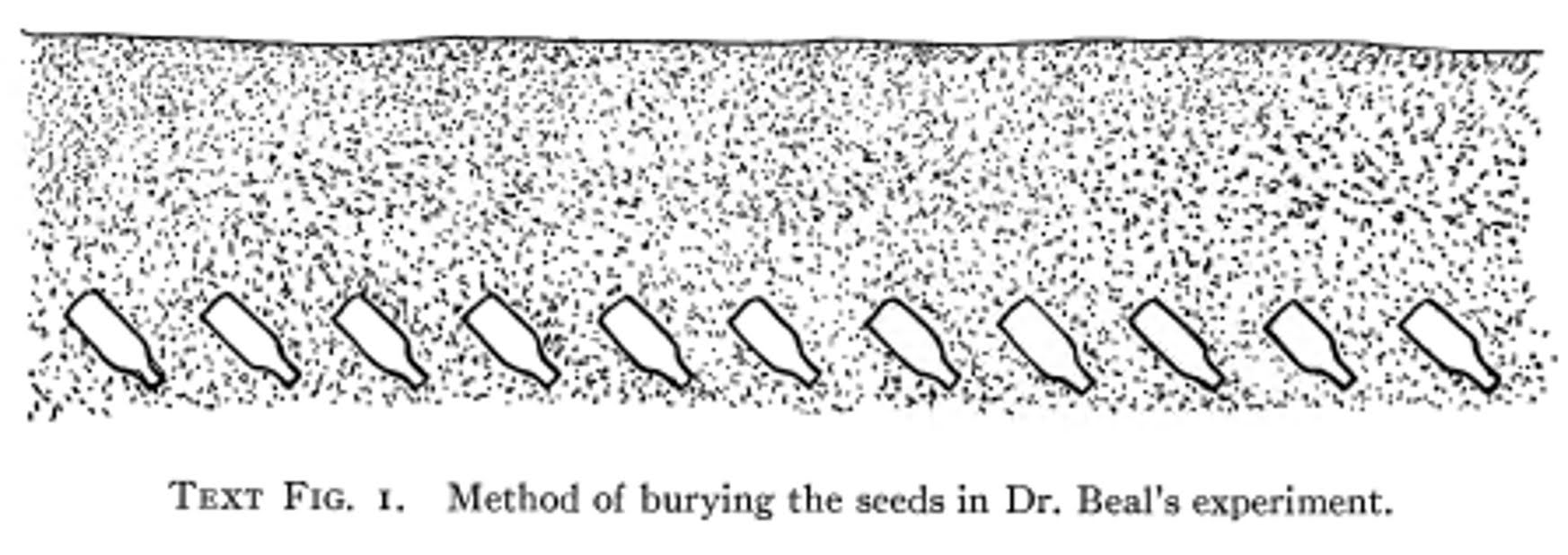Beal Seed Experiment
In the fall of 1879, Professor William James Beal began an experiment to determine “the length of time seeds of some of our most common plants would remain dormant in the soil and yet germinate when exposed to favorable conditions.” This experiment in seed longevity is still active today, and has become one of the longest continuously monitored scientific experiments in the world.

Professor Beal describes the experiment best: ‘‘I selected fifty freshly grown seeds of each of twenty-three different kinds of plants. Twenty such lots were prepared with the view of testing them at different times in the future. Each lot or set of seeds was well mixed in moderately moist sand, just as it was taken from three feet below the surface, where the land had never been plowed. The seeds of each set were well mixed with the sand and placed in a pint bottle, the bottle being filled and left uncorked and placed with the mouth slanting downward so that water could not accumulate about the seeds. These bottles were buried on a sandy knoll in a row running east and west.’’
During the first 40 years of the experiment, eight of the twenty bottles were unearthed as germination tests were carried out every five years. The period between germination tests was extended to ten years in 1920 by Dr. Darlington, who took over the experiment from Professor Beal in 1915. By 1980, the 100th anniversary of the study, the interval was extended to twenty years. The 16th bottle was unearthed in 2021 and the next bottle of the four remaining will be unearthed in 2040.
Twenty Verbascum seeds germinated from the 2021 bottle, meaning we have not yet determined their longevity. And as Beal stated in a later paper, “In all tests of the seeds buried in bottles, the results have been indefinite and far from satisfactory. I mean by this that I have never felt certain that I had induced all the sound seeds to germinate. I moisten the sand containing the seeds, and forth with a goodly number germinate, and then they come slowly straggling along. I dry the soil and wait a few days, and after moistening, in a few days more seeds germinate. Why was I unable to induce them to start when treated to various degrees of temperature and moisture for seven months?” We may yet see that ungerminated seeds remaining from this latest germination experiment are in fact viable, and simply haven’t been exposed to the right conditions.
Since Beal began the experiment in 1879, a number of scientists have been engaged in the continuing research:
1879-1909: Professor W. J. Beal
1914-1950: Professor H.T. Darlington
1960: Professor H.T. Darlington & G. P. Steinbauer
1970-1980: Drs. A. Kivilaan and R.S. Bandurski
2000: Drs. F.W. Telewski and J.A.D. Zeevaart (American Journal of Botany publication: https://doi.org/10.3732/ajb.89.8.1285)
2021: Drs. F.W. Telewski, L. Brudvig, M. Weber, D. Lowry and M. Fleming
Text contributed by Dr. Margaret Fleming and adapted for use by Anna McGuffie.
Learn more about the 2021 bottle:
MSU Today: "Unearthing a scientific mystery MSU’s 142-year-old Beal Seed Experiment keeps growing"
The New York Times: "One of the World’s Oldest Science Experiments Comes Up From the Dirt"
NPR All Things Considered: "The Secret Mission to Unearth Part Of A 142-Year Old Experiment"